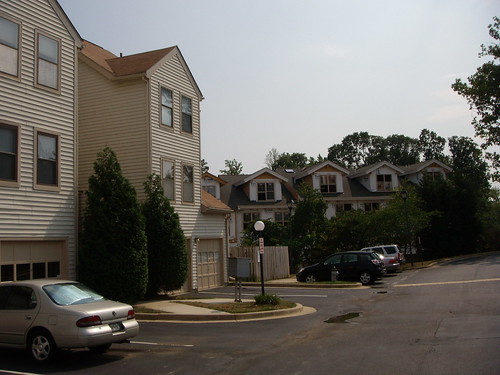Don't forget to vote in today's District 4 Special Election! To find your polling place, check out the Board of Elections website.
 Condos and townhomes in Briggs Chaney.
Condos and townhomes in Briggs Chaney.
With clusters of self-contained apartment and townhome complexes, places like White Oak and Briggs Chaney have all of the problems of density with few of the benefits. They're compact enough that residents could (and often do) walk to amenities like schools, shopping and transit, but because they're divided into isolated complexes and built with few connecting streets, these neighborhoods have become decidedly car-oriented environments - and they've got the traffic congestion to show for it.
Not only that, but they discourage the formation of community. The yearly East County Community Day, hosted by the Windsor Court and Tower apartments, doesn't draw nearly as many people as it could - both from within Briggs Chaney and the greater area - because it's tucked away inside one apartment complex, out of sight and out of mind.
What would it take to make these communities into functioning, pedestrian-friendly urban places? Chris Bradford from the Austin Contrarian blog writes about Austin's "apartment city," a place that sounds strangely like Briggs Chaney, and says it's a waste that a dense neighborhood can't also be a paragon of good urbanism as well:
 Condos and townhomes in Briggs Chaney.
Condos and townhomes in Briggs Chaney.With clusters of self-contained apartment and townhome complexes, places like White Oak and Briggs Chaney have all of the problems of density with few of the benefits. They're compact enough that residents could (and often do) walk to amenities like schools, shopping and transit, but because they're divided into isolated complexes and built with few connecting streets, these neighborhoods have become decidedly car-oriented environments - and they've got the traffic congestion to show for it.
Not only that, but they discourage the formation of community. The yearly East County Community Day, hosted by the Windsor Court and Tower apartments, doesn't draw nearly as many people as it could - both from within Briggs Chaney and the greater area - because it's tucked away inside one apartment complex, out of sight and out of mind.
What would it take to make these communities into functioning, pedestrian-friendly urban places? Chris Bradford from the Austin Contrarian blog writes about Austin's "apartment city," a place that sounds strangely like Briggs Chaney, and says it's a waste that a dense neighborhood can't also be a paragon of good urbanism as well:
"It occurred to me that this vast stretch of apartment buildings was a tremendous missed opportunity. With just a little rearranging, these apartments could have been transformed into a pleasant urban neighborhood of 20 or 30 blocks.Check out the original post to read the rest.
The complexes contain literally scores of individual buildings. It would have been easy to arrange them in a grid fronting public streets with alleys in the back. The only significant architectural modification would have been closing in the breezeways/stairwells to create common entrances . . . I have to believe that lots of prospective tenants would have preferred an urban layout. They would have gotten pleasant, proper neighborhoods, with a store or two nearby -- the complexes are dense enough to support a couple of small retail uses were they not walled off from one another.
The only drawback -- and I acknowledge it could be a big one -- is safety. Those tall fences and gates provide a sense of security. Now, they don't make it difficult to get into the complex. In large complexes with hundreds of residents, the gates are constantly opening or closing. (I freely wandered in and out of one yesterday.) But the fences and gates do make it harder to get out, which deters criminals. Complexes like these of course experience assaults and car break-ins, but I'm sure they're safer than similar complexes that lack fences and gates.
Proper urban neighborhoods provide their own deterrents, though. A short block lined with dense walk-ups has lots of eyes and ears on the street. Good lighting is another deterrent. As is steady traffic."

No comments:
Post a Comment